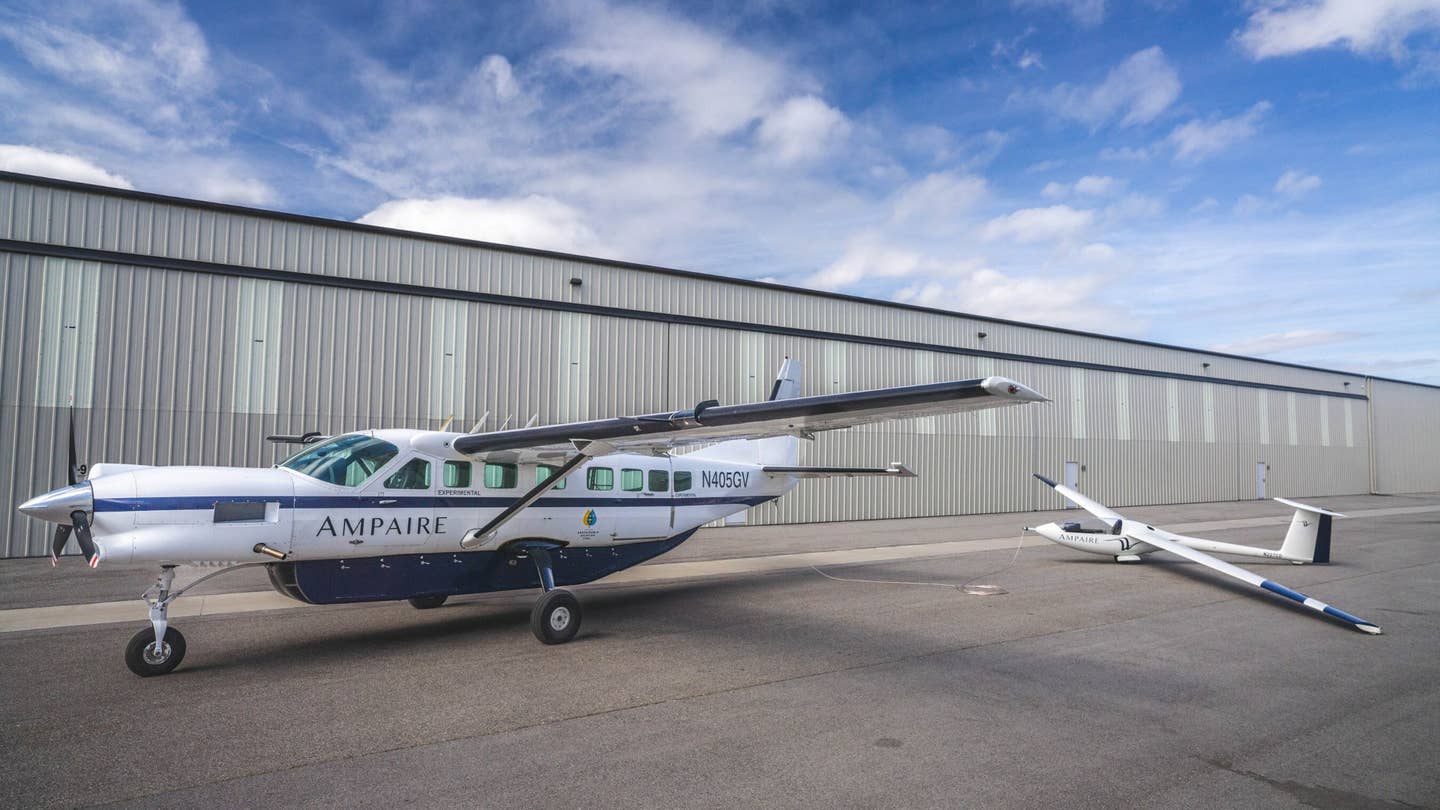Hybrid-Electric Propulsion Developer Ampaire Acquires Magpie Aviation
The company will inherit several pending patents and government contracts to ramp up development of its hybrid-electric propulsion system.

Ampaire’s flagship nine-seat Eco Caravan (left) could be towed by electrified tow aircraft from Magpie. [Courtesy: Ampaire]
Ampaire, a developer of hybrid-electric propulsion systems and manufacturer of the Eco Caravan—a nine-seat, modified Cessna 208B Grand Caravan—believes it now holds the key to extending the range of electric and hybrid-electric aircraft.
The company on Monday announced its acquisition of electric aviation technology developer Magpie Aviation, including the company’s Aerotowing solution, for an undisclosed fee. Magpie Aerotowing uses electrified tow aircraft to stretch out the flight time of larger electric models.
Ampaire will also inherit multiple pending Magpie patents and pending and existing government contracts. The company said these will help it further develop Magpie’s solution, as well as its proprietary propulsion system.
“We founded Magpie because we believe electrified aircraft have a pivotal role to play in the future of aviation,” said Damon Vander Lind, CEO of Magpie. “I am thrilled to see this vision continuing to move forward under Ampaire's banner. Not only does this lift the prospects of civilian electric aircraft and meaningful emission reductions in the future, it also helps Ampaire to serve military customers with their needs, right now.”
According to Magpie, electric aircraft are often limited to short routes due to battery energy density constraints. The company is developing technology to counteract this: specifically, a network of electric tow aircraft that could enable zero-emission flights of electric vertical takeoff and landing (eVTOL) and other electric aircraft beyond 1,000 sm (869 nm).
Here’s how it works. An electrified main aircraft takes off and climbs to its cruising altitude, while a tow aircraft departs from a charging station at a nearby, secondary airport. The pair meet autonomously in the sky and are connected at a safe distance. The tow aircraft then begins towing while the main aircraft idles and can be swapped out en route to enable even longer flights.
Last year, Magpie demonstrated what claimed were the world's first automated towing connections between two flying aircraft. Its autonomous Active Hook system tracked, positioned, and connected two aircraft in repeated tests “with centimeter-level precision,” according to the company.
Magpie said Aerotowing becomes cost-competitive at scale, despite the involvement of extra aircraft. Airlines would be able to operate large electric aircraft over longer distances, which the firm said could help them save on fuel and maintenance costs.
Those savings may also offset the added cost of towing, which Magpie said is “kept economical” by operating simple aircraft out of secondary airports. Citing research from Bain Capital, the company claims battery-electric designs will be “substantially cheaper” to operate than sustainable aviation fuel (SAF) or hydrogen-powered aircraft.
Magpie owns several strategic government contracts, including with the U.S. Air Force, which Ampaire said it will continue. The company also said it will leverage Magpie’s pending contracts and patents when they come to fruition.
“With this acquisition, Ampaire anticipates further revenue growth across both commercial and defense sectors while simultaneously enhancing the capabilities and mission scope of our existing hybrid aircraft,” said Kevin Noertker, CEO of Ampaire. “Building upon our recent acquisition of Talyn Air, the addition of Magpie exemplifies our deliberate approach to integrating pivotal companies and assets on our path to accelerate our leadership in electrified aviation.”
Ampaire’s AMP-H570 AMP Drive hybrid-electric propulsion unit can be integrated into both general aviation and regional turboprop commercial aircraft. The systems have flown more than 25,000 sm to date, the company said, claiming that no one in the industry has more hybrid-electric flight time. That includes a 12-hour flight of the company’s Electric EEL demonstrator in December, which set the endurance record for hybrid-electric aircraft.
The firm’s flagship aircraft, however, is the nine-seat Eco Caravan, which has an estimated 1,100 sm (956 nm) range and 2,500-pound payload. Ampaire in 2022 said the model could be the first electrified regional aircraft to enter commercial service. It hopes to earn a supplemental type certificate from the FAA by year’s end.
The Eco Caravan is equipped with Ampaire’s proprietary propulsion system, which it said will reduce fuel consumption and emissions by 50 to 70 percent compared to conventional Pratt & Whitney PT6 engines. PT6s are common on Cessna Caravan turboprops.
Ampaire’s acquisition of Magpie follows its July purchase of eVTOL manufacturer Talyn Air, through which it also inherited several defense contracts and patents. It intends to leverage these to add its systems to eVTOL aircraft, in addition to Cessnas and de Havilland Twin Otter DHC6s it is already modifying.
Noertker in July told FLYING his hope is for the company to become the go-to propulsion systems firm for both conventional and emerging aircraft. The Ampaire CEO sees near-term applications for eVTOL aircraft in defense and cargo delivery, but his primary focus remains on electrifying conventional aircraft.
Like this story? We think you'll also like the Future of FLYING newsletter sent every Thursday afternoon. Sign up now.

Subscribe to Our Newsletter
Get the latest FLYING stories delivered directly to your inbox






